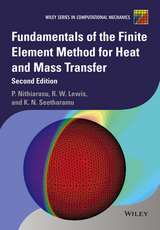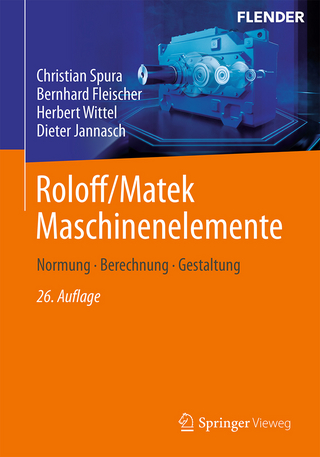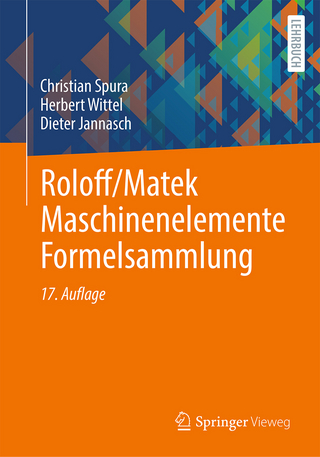
Fundamentals of the Finite Element Method for Heat and Fluid Flow
John Wiley & Sons Ltd (Verlag)
978-0-470-84789-3 (ISBN)
- Titel erscheint in neuer Auflage
- Artikel merken
This book:* Is ideal for teaching senior undergraduates the fundamentals of how to use the Finite Element Method to solve heat transfer and fluid dynamics problems* Explains how to solve various heat transfer problems with different types of boundary conditions* Uses recent computational methods and codes to handle complex fluid motion and heat transfer problems* Includes a large number of examples and exercises on heat transfer problemsIn an era of parallel computing, computational efficiency and easy to handle codes play a major part. Bearing all these points in mind, the topics covered on combined flow and heat transfer in this book will be an asset for practising engineers and postgraduate students. Other topics of interest for the heat transfer community, such as heat exchangers and radiation heat transfer, are also included.
Preface. 1 Introduction. 1.1 Importance of Heat Transfer. 1.2 Heat Transfer Modes. 1.3 The Laws of Heat Transfer. 1.4 Formulation of Heat Transfer Problems. 1.4.1 Heat transfer from a plate exposed to solar heat flux. 1.4.2 Incandescent lamp. 1.4.3 Systems with a relative motion and internal heat generation. 1.5 Heat Conduction Equation. 1.6 Boundary and Initial Conditions. 1.7 Solution Methodology. 1.8 Summary. 1.9 Exercise. Bibliography. 2 Some Basic Discrete Systems. 2.1 Introduction. 2.2 Steady State Problems. 2.2.1 Heat flow in a composite slab. 2.2.2 Fluid flow network. 2.2.3 Heat transfer in heat sinks (combined conduction-convection). 2.2.4 Analysis of a heat exchanger. 2.3 Transient Heat Transfer Problem (Propagation Problem). 2.4 Summary. 2.5 Exercise. Bibliography. 3 The Finite Elemen t Method. 3.1 Introduction. 3.2 Elements and Shape Functions. 3.2.1 One-dimensional linear element. 3.2.2 One-dimensional quadratic element. 3.2.3 Two-dimensional linear triangular elements. 3.2.4 Area coordinates. 3.2.5 Quadratic triangular elements. 3.2.6 Two-dimensional quadrilateral elements. 3.2.7 Isoparametric elements. 3.2.8 Three-dimensional elements. 3.3 Formulation (Element Characteristics). 3.3.1 Ritz method (Heat balance integral method-Goodman's method). 3.3.2 Rayleigh-Ritz method (Variational method). 3.3.3 The method of weighted residuals. 3.3.4 Galerkin finite element method. 3.4 Formulation for the Heat Conduction Equation. 3.4.1 Variational approach. 3.4.2 The Galerkin method. 3.5 Requirements for Interpolation Functions. 3.6 Summary. 3.7 Exercise. Bibliography. 4 Steady State Heat Conduction in One Dimension. 4.1 Introduction. 4.2 Plane Walls. 4.2.1 Homogeneous wall. 4.2.2 Composite wall. 4.2.3 Finite element discretization. 4.2.4 Wall with varying cross-sectional area. 4.2.5 Plane wall with a heat source: solution by linear elements. 4.2.6 Plane wall with a heat source: solution by quadratic elements. 4.2.7 Plane wall with a heat source: solution by modified quadratic equations (static condensation). 4.3 Radial Heat Flow in a Cylinder. 4.3.1 Cylinder with heat source. 4.4 Conduction-Convection Systems. 4.5 Summary. 4.6 Exercise. Bibliography. 5 Steady State Heat Conduction in Multi-dimensions. 5.1 Introduction. 5.2 Two-dimensional Plane Problems. 5.2.1 Triangular elements. 5.3 Rectangular Elements. 5.4 Plate with Variable Thickness. 5.5 Three-dimensional Problems. 5.6 Axisymmetric Problems. 5.6.1 Galerkin's method for linear triangular axisymmetric elements. 5.7 Summary. 5.8 Exercise. Bibliography. 6 Transient Heat Conduction Analysis. 6.1 Introduction. 6.2 Lumped Heat Capacity System. 6.3 Numerical Solution. 6.3.1 Transient governing equations and boundary and initial conditions. 6.3.2 The Galerkin method. 6.4 One-dimensional Transient State Problem. 6.4.1 Time discretization using the Finite Difference Method (FDM). 6.4.2 Time discretization using the Finite Element Method (FEM). 6.5 Stability. 6.6 Multi-dimensional Transient Heat Conduction. 6.7 Phase Change Problems-Solidification and Melting. 6.7.1 The governing equations. 6.7.2 Enthalpy formulation. 6.8 Inverse Heat Conduction Problems. 6.8.1 One-dimensional heat conduction. 6.9 Summary. 6.10 Exercise. Bibliography. 7 Convection Heat Transfer 173 7.1 Introduction. 7.1.1 Types of fluid-motion-assisted heat transport. 7.2 Navier-Stokes Equations. 7.2.1 Conservation of mass or continuity equation. 7.2.2 Conservation of momentum. 7.2.3 Energy equation. 7.3 Non-dimensional Form of the Governing Equations. 7.3.1 Forced convection. 7.3.2 Natural convection (Buoyancy-driven convection). 7.3.3 Mixed convection. 7.4 The Transient Convection-diffusion Problem. 7.4.1 Finite element solution to convection-diffusion equation. 7.4.2 Extension to multi-dimensions. 7.5 Stability Conditions. 7.6 Characteristic-based Split (CBS) Scheme. 7.6.1 Spatial discretization. 7.6.2 Time-step calculation. 7.6.3 Boundary and initial conditions. 7.6.4 Steady and transient solution methods. 7.7 Artificial Compressibility Scheme. 7.8 Nusselt Number, Drag and Stream Function. 7.8.1 Nusselt number. 7.8.2 Drag calculation. 7.8.3 Stream function. 7.9 Mesh Convergence. 7.10 Laminar Isothermal Flow. 7.10.1 Geometry, boundary and initial conditions. 7.10.2 Solution. 7.11 Laminar Non-isothermal Flow. 7.11.1 Forced convection heat transfer. 7.11.2 Buoyancy-driven convection heat transfer. 7.11.3 Mixed convection heat transfer. 7.12 Introduction to Turbulent Flow. 7.12.1 Solution procedure and result. 7.13 Extension to Axisymmetric Problems. 7.14 Summary. 7.15 Exercise. Bibliography. 8 Convection in Porous Media. 8.1 Introduction. 8.2 Generalized Porous Medium Flow Approach. 8.2.1 Non-dimensional scales. 8.2.2 Limiting cases. 8.3 Discretization Procedure. 8.3.1 Temporal discretization. 8.3.2 Spatial discretization. 8.3.3 Semi- and quasi-implicit forms. 8.4 Non-isothermal Flows. 8.5 Forced Convection. 8.6 Natural Convection. 8.6.1 Constant porosity medium. 8.7 Summary. 8.8 Exercise. Bibliography. 9 Some Examples of Fluid Flow and Heat Transfer Problems. 9.1 Introduction. 9.2 Isothermal Flow Problems. 9.2.1 Steady state problems. 9.2.2 Transient flow. 9.3 Non-isothermal Benchmark Flow Problem. 9.3.1 Backward-facing step. 9.4 Thermal Conduction in an Electronic Package. 9.5 Forced Convection Heat Transfer From Heat Sources. 9.6 Summary. 9.7 Exercise. Bibliography. 10 Implementation of Computer Code. 10.1 Introduction. 10.2 Preprocessing. 10.2.1 Mesh generation. 10.2.2 Linear triangular element data. 10.2.3 Element size calculation. 10.2.4 Shape functions and their derivatives. 10.2.5 Boundary normal calculation. 10.2.6 Mass matrix and mass lumping. 10.2.7 Implicit pressure or heat conduction matrix. 10.3 Main Unit. 10.3.1 Time-step calculation. 10.3.2 Element loop and assembly. 10.3.3 Updating solution. 10.3.4 Boundary conditions. 10.3.5 Monitoring steady state. 10.4 Postprocessing. 10.4.1 Interpolation of data. 10.5 Summary. Bibliography. A Green's Lemma. B Integration Formulae. B.1 Linear Triangles. B.2 Linear Tetrahedron. C Finite Element Assembly Procedure. D Simplified Form of the Navier-Stokes Equations. Index.
| Erscheint lt. Verlag | 13.4.2004 |
|---|---|
| Zusatzinfo | illustrations |
| Verlagsort | Chichester |
| Sprache | englisch |
| Maße | 170 x 244 mm |
| Gewicht | 586 g |
| Themenwelt | Technik ► Maschinenbau |
| ISBN-10 | 0-470-84789-1 / 0470847891 |
| ISBN-13 | 978-0-470-84789-3 / 9780470847893 |
| Zustand | Neuware |
| Informationen gemäß Produktsicherheitsverordnung (GPSR) | |
| Haben Sie eine Frage zum Produkt? |
aus dem Bereich



